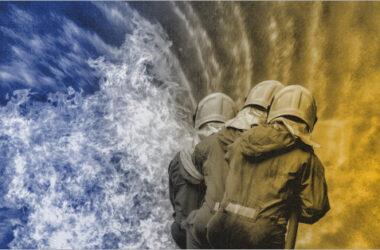Insurance plays a crucial role in safeguarding individuals and their assets from unforeseen risks and disasters. While life, vehicle, and standard home insurance are commonly sought after, the importance of earthquake insurance cannot be understated, especially in regions prone to seismic activity. Earthquakes have the potential to cause extensive damage to homes, and in some cases, complete destruction. This write-up explores the significance of earthquake insurance, focusing on India, a country vulnerable to major seismic events.
Let’s continue the discussion with an interesting insight from the pages of history.
The history of earthquake insurance is closely intertwined with that of Fire Insurance, with the relationship between the two initially evolving unknowingly. The 1906 San Francisco earthquake, which caused approximately US$330 million dollars worth of property damage, played a pivotal role in shaping the development of earthquake insurance.
In the aftermath of the San Francisco earthquake, it was observed that while damage due to shaking was not covered by insurance at the time, a significant portion of the property damage was attributed to fire. Interestingly, the fire policies of that era did not specifically exclude coverage for fire following an earthquake. This observation led to a cautious and evolving approach to earthquake insurance in regions of the United States and other places known to have significant earthquake risks.
As a result of the San Francisco earthquake, three distinct approaches to earthquake insurance emerged:
Earthquake Included in Standard Fire Policies: In this approach, earthquake coverage became a standard peril within Fire Insurance Policies. This meant that policyholders automatically received protection against earthquake damage as part of their Fire Insurance without the need for separate policies or endorsements.
Additional Earthquake Peril: In contrast to the first approach, earthquake insurance could also be offered as an additional peril, either as a standalone policy or as an add-on to a standard Fire Insurance Policy. In cases where earthquake coverage was provided as an add-on, special conditions and terms might be attached to the policy to address the unique risks associated with earthquakes.
Government-Based, Compulsory Schemes: Some regions, recognizing the substantial earthquake risks they faced, established government-based earthquake insurance schemes. These schemes were often compulsory, meaning that property owners were required by law to purchase earthquake insurance. Such government-backed programs aimed to ensure widespread coverage and financial protection for property owners in earthquake-prone areas.
Earthquake Risk in India
India is a nation that lies within a region vulnerable to major earthquakes. The 2001 Bhuj earthquake, which struck western and northern India, serves as a stark reminder of the devastation that can result from such natural disasters. The aftermath of an earthquake can lead to significant loss of life and property. Therefore, investing in home insurance that includes earthquake coverage is not only prudent but also financially responsible. The cost of acquiring earthquake insurance is significantly lower than the potential expenses associated with rebuilding a house or property in the aftermath of an earthquake.
Understanding Earthquake Zones in India
To effectively assess earthquake risk and determine insurance coverage, India is divided into four seismic zones based on the frequency and magnitude of earthquakes that can occur in each area:
Zone I: This zone covers northeastern India, including parts of Himachal Pradesh, parts of North Bihar, the Andaman & Nicobar Islands, Uttaranchal, Jammu and Kashmir, and the Rann of Kutch in Gujarat.
Zone II: Classified in the Moderate Damage Risk Zone. This includes the Union Territory of Delhi, Sikkim, northern parts of Uttar Pradesh, Bihar, the remaining parts of Jammu & Kashmir and Himachal Pradesh, West Bengal, parts of Gujarat, small portions of Maharashtra along the west coast, and Rajasthan.
Zone III: It includes states like Kerala, Goa, Lakshadweep islands, and the remaining parts of West Bengal, Punjab, Uttar Pradesh, Gujarat, Rajasthan, Madhya Pradesh, Maharashtra, Orissa, Bihar, Jharkhand, Chhattisgarh, Andhra Pradesh, Tamil Nadu, and Karnataka.
Zone IV: A Very Low Damage Risk Zone, covering the rest of the country.
What’s Included in Earthquake Insurance
Earthquake insurance typically covers the following aspects:
Fire: Coverage for structural and content damage resulting from a fire caused by an earthquake.
Valuables: Protection against damage to valuable possessions within the insured property.
What’s Not Included in Earthquake Insurance
It is essential to be aware of what earthquake insurance does not cover:
Floods: Damage resulting from flooding that follows an earthquake is not included.
Deductibles: Any deductibles outlined in the policy are excluded from coverage.
Earnings: Loss of earnings or indirect damage of any kind is not covered.
Fees: Fees for architects, surveyors, or consulting engineers (in excess of 3% of the claim amount) are not covered.
Debris: The policy does not cover the cost of debris removal.
Rent: Loss of rent is not included in earthquake insurance coverage.
Additional Expense: Additional expenses incurred due to renting alternative accommodation are not covered.
Lapsed Policy: Damages occurring outside the insurance period are not covered.
The Significance of Fire Insurance in Earthquake Zones
Vulnerability to Secondary Hazards: Earthquakes can trigger fires through various means, including gas leaks, electrical short circuits, and structural damage. In earthquake-prone regions, the risk of fires as a secondary hazard is significantly heightened.
Compounding Losses: In the case of earthquake-induced fire, the financial burden can be exponentially higher. Property damage from both the earthquake and the ensuing fire can lead to substantial losses.
Key Elements of Fire Insurance in Earthquake Zones:
Coverage Extensions: In earthquake-prone areas, standard Fire Insurance Policies often incorporate extensions that cover losses resulting from fires triggered by earthquakes. Policyholders should carefully review these extensions and understand the scope of coverage.
Policy Limits and Deductibles: Policy limits and deductibles may be adjusted to account for the increased risk in earthquake zones. It’s crucial for policyholders to assess their coverage limits and consider purchasing additional coverage if necessary.
Building and Retrofitting Requirements: Insurance providers may require policyholders to implement earthquake-resistant building measures, such as seismic retrofitting, to mitigate the risk of fire. Compliance with these requirements may affect premium rates.
Mitigation Measures: Insurers may offer discounts to policyholders who take proactive steps to minimize fire risk, such as installing fire-resistant roofing materials or maintaining clear defensible space around properties.
In the Nutshell
Fire Insurance in earthquake zones is a crucial aspect of risk management. Earthquakes increase the likelihood of fires, and the resulting property damage can be financially devastating. Policyholders must carefully evaluate their risk, choose appropriate coverage, and take preventive measures to protect their assets. Likewise, insurers must tailor policies to reflect the unique challenges posed by earthquake zones. By navigating these considerations collaboratively, individuals and businesses can better prepare for and mitigate the financial impacts of fires in earthquake-prone regions.








